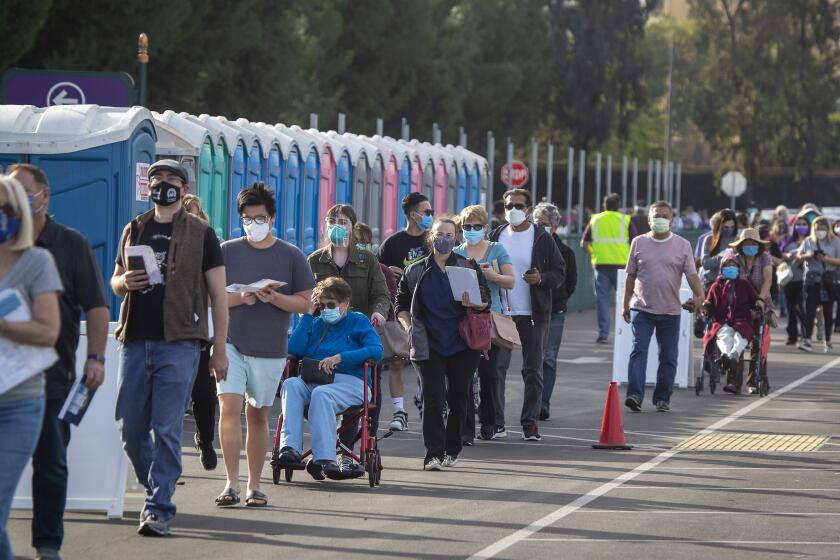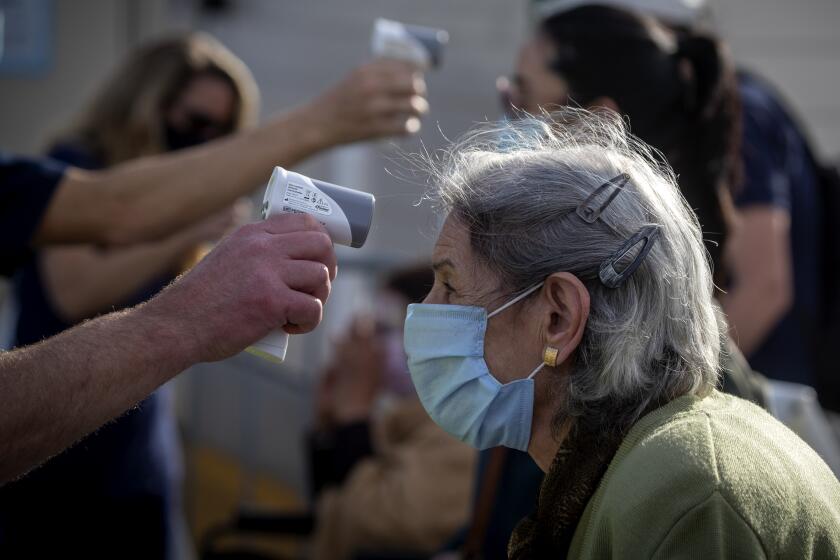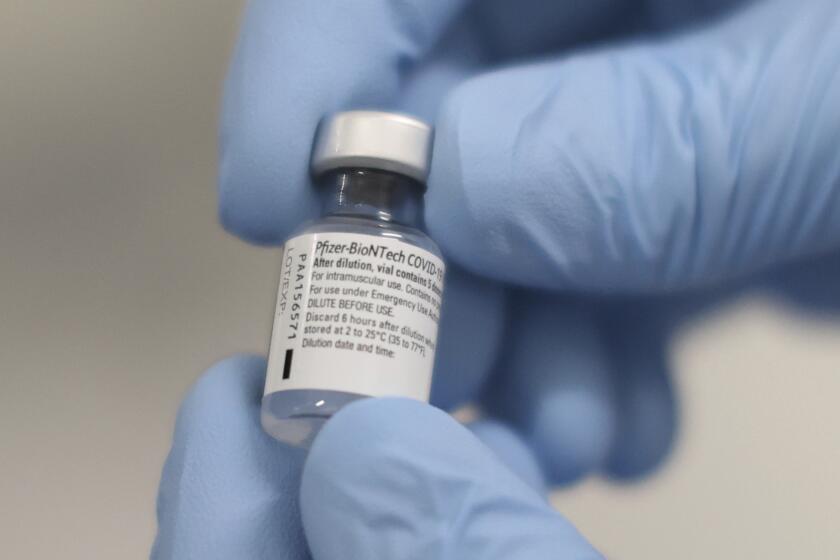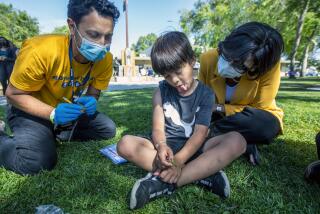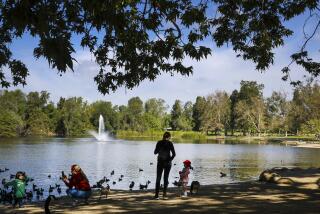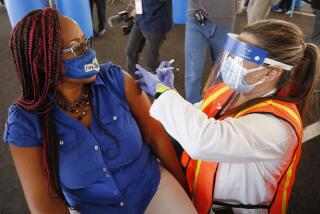L.A.’s big bet: Turning Dodger Stadium into mass COVID-19 vaccine site
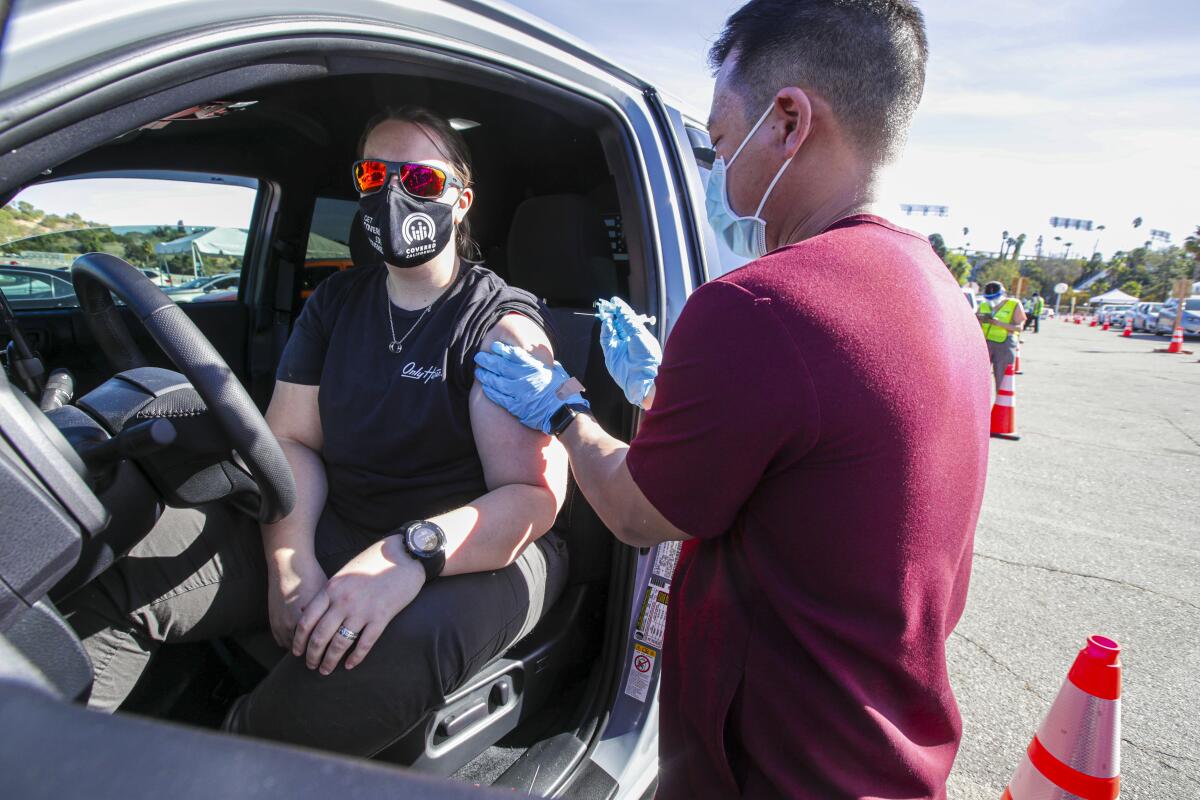
The plan goes like this: Anyone eligible for a coronavirus vaccine will be able to drive to Dodger Stadium, roll down their car window and get an injection.
About 12,000 people a day will get shots under the ambitious goals for what will probably be one of the country’s largest vaccination sites, set to open Friday at 8 a.m.
As California officials rush to set up vaccination “super sites” at Dodger Stadium, Disneyland and other major landmarks in a bid to improve one of the country’s lowest per-capita vaccination rates, they’re facing even bigger hurdles than in the early days of mass coronavirus testing.
Amid surging caseloads and a growing frustration with the slow vaccine rollout, there is little margin for error.
State residents 65 and older are now eligible for the vaccine, but in Los Angeles County, they can’t receive it until officials finish vaccinating at least 500,000 healthcare industry and nursing home workers.
Officials hope to begin vaccinating seniors by early February, along with teachers and workers in child care, emergency services, food and agriculture.
It was a day of frustration for seniors trying to make appointments. Some were able to schedule them at retailers but it’s unclear whether those will be honored.
“I know how frustrating it must seem now,” said Dr. Barbara Ferrer, L.A. County’s public health director. “We actually don’t have enough vaccine right now to be able to get done more quickly with our healthcare workers.”
Starting early in the pandemic, Dodger Stadium served as one of the country’s largest coronavirus testing sites, processing up to 13,000 tests per day. The city of Los Angeles announced Sunday that the site would be converted to a vaccine-only center in less than a week.
Managing a mass vaccine site poses more logistical challenges than a testing program, which relied largely on self-administered oral-swab tests.
Health professionals must perform the injection and closely monitor each vaccine recipient. Scheduling appointments is more complicated because people must be screened and then tracked down for their second dose. The timing is also delicate: Staff have to thaw and prepare enough doses to keep the line moving quickly, but not so many that the shots expire.
Finding enough clinicians for the mega-sites will add more demands to a healthcare system stretched to the breaking point. Some L.A. Fire Department personnel have already been pulled off their normal duties to staff test sites.
COVID-19 vaccinations will be given at five sites: Pomona Fairplex, the Forum, Cal State Northridge, L.A. County Office of Education and Six Flags.
“We’re deploying a whole workforce to administer shots, and doing it all without this clear sense of when vaccines will arrive from the federal government,” Mayor Eric Garcetti said. “But we have to take that risk.”
Garcetti said Thursday that the city shut down coronavirus testing at Dodger Stadium and at the V.A. in Westwood because “we needed personnel from two testing sites just to match what we need for vaccinations in one.”
Setting up a drive-through vaccination site has required “layers and layers of planning and logistics that did not exist in a test site,” said Deputy Mayor Jeff Gorell, who handles public safety issues for Mayor Eric Garcetti. “There’s just more steps and processes and security considerations.”
California’s COVID-19 vaccine rollout has already been slowed by supply shortages and logistical woes.
Its opening comes after other vaccination mega-sites have sprung up across the country over the last week. Among the largest is the Javits Center in New York City, with the capacity to vaccinate 25,000 people per day. Some sites, like the State Farm Stadium outside Phoenix, are open 24 hours a day, seven days a week to vaccinate people as they sit in their cars. All of the appointments for January at that site, which can serve as many as 6,000 people per day, have been filled.
The city is working with CORE Response, Carbon Health, USC and the LAFD to plan and operate the site, he said. The plans are partly informed by the city’s experience administering drive-through flu shots over the last three months.
Dodger Stadium will be open to healthcare workers with appointments between 8 a.m. and 8 p.m. They will be stopped before they enter the site and asked to show photo identification and proof of employment, Gorell said.
Then they’ll be directed to one of three smaller sites inside the parking lot complex, run by the LAFD, each of which have its own clinicians and support staff.
Cars will pull through in groups of 10. Clinicians will approach the vehicles with a wheeled cart, conduct the pre-screening interview and administer the shot through the car window, Gorell said — a process that will take about 15 minutes for all 10 vehicles.
Then the patients will wait in their cars for 15 minutes during the observation period while clinicians move on to the next group.
COVID-19 vaccines are now being administered to healthcare workers in the U.S. What are your questions about the timeline, the safety or the science?
Nearly 200 people will work at Dodger Stadium daily, the mayor’s office said. That includes 42 clinicians to handle pre-vaccine screenings and the vaccinations themselves, as well as supervisors, traffic control officers and people to do data entry and administrative work.
“There’s so much work and so many logistics on the back end,” said Richard Dang, an assistant professor of clinical pharmacy at USC, which is operating a city vaccination site in Lincoln Park and providing clinicians and vaccinators to the Dodger Stadium site.
The Lincoln Park site is administering about 1,000 to 1,200 vaccines per day, Dang said. That requires a staff of about 30 to 40 people working an eight-hour shift, of whom about 10 are administering the shots, he said.
Other workers are doing the less visible work of making the site run smoothly: Supervising pharmacy students, preparing doses and loading syringes, filling out a vaccination card for each person, screening people for allergic reactions, and ensuring that everyone qualifies for the shot.
USC faculty, staff and students are volunteering at Lincoln Heights and Dodger Stadium, as are students from four other colleges. Everyone needs to have a pharmacy license in California, a training certificate for immunizations from the National Pharmacists Assn., and credentials for administering CPR, Dang said.
The USC School of Pharmacy is also accepting volunteers who are retired, or alumni of the pharmacy program, provided they have valid and current credentials, Dang said.
At Dodger Stadium, the city aims to administer roughly 1,100 vaccines per hour by next week, and about 12,000 per day, Gorell said. But the site will run at lower capacity Friday and Saturday to work out any kinks with the registration system or the vaccine supply chain.
County officials are sending 46,000 doses to the city to be disbursed between all the vaccination sites, Gorell said. But, he said, “we don’t know what the world looks like after Wednesday.”
At the Disneyland mega-vaccination site, Orange County health officials hope to vaccinate at least 7,000 people per day. The site will be staffed by around 200 workers, including city and county employees and volunteers recruited and screened by a nonprofit organization, said spokeswoman Jessica Good of the Orange County Health Care Agency.
Orange County is aiming to vaccinate everyone in the county by July 4, which would require administering about 8,000 vaccines per day, said health officer Dr. Clayton Chau.
“We still have to come up with an infrastructure to support this effort,” Chau told county officials Monday. “This is not like the regular seasonal flu vaccine. This is not that simple. It’s very complex.”
Times staff writer Hayley Smith contributed to this report.
More to Read
Sign up for Essential California
The most important California stories and recommendations in your inbox every morning.
You may occasionally receive promotional content from the Los Angeles Times.
